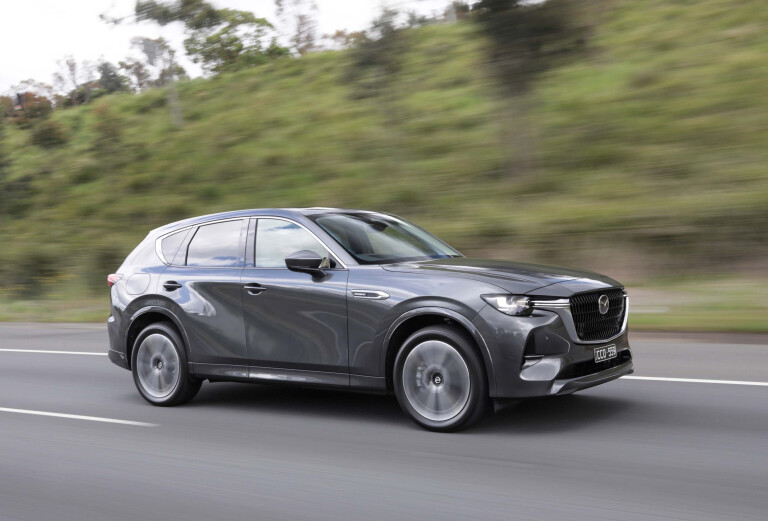
Snapshot
- Full Aussie pricing and range details
- Prices start at $59K and stretch to just below $90K making it Mazda’s most expensive model
- CX-60 brings a new platform
- Fresh six-cylinder engines and Mazda’s first plug-in hybrid
- Australian launch set for June 2023
Pricing and full Australian details have been revealed for the highly-anticipated 2023 Mazda CX-60 mid-size SUV, with order books opening from today.
Set to arrive in June 2023, the CX-60 is the first model built on Mazda’s all-new modular Large Architecture platform and it ushers in a pair of fresh 3.3-litre six-cylinder engines and Mazda’s first plug-in hybrid.
Prices start at $59,800 for the petrol-powered G40e Evolve and stretch to $85,500 for the flagship P50e plug-in hybrid. That makes the CX-60 easily the most expensive model in Mazda’s current line-up and if you add one or two option packs (more detail on these further down) it also means a top-of-the-line CX-60 will be approaching $100,000 once you factor in on-road costs.
2023 Mazda CX-60 Australian pricing
| Evolve | GT | Azami | |
|---|---|---|---|
| 3.3L petrol | $59,800 | $67,800 | $73,000 |
| 3.3L diesel | $61,800 | $69,800 | $75,000 |
| 2.5L PHEV | $72,300 | $80,300 | $85,500 |
Powertrains
The Aussie model range spans three model grades – Evolve, GT and Azami – and each is available with the choice of three new powertrains.
Expected to be the most popular engine is a new 3.3-litre straight-six turbo petrol, which Mazda predicts will account for 45 per cent of total sales. Dubbed G40e, the inline petrol produces 209kW/450Nm, is paired with a 48-volt mild hybrid system and propels the circa-2000 kilogram CX-60 from 0-100km/h in 6.9 seconds.
Also utilising 3.3-litres of swept capacity is a six-cylinder turbo-diesel, known as D50e. It too is paired with a mild-hybrid system, though it produces 187kW/550Nm and is slightly slower to 100km/h at 7.3 seconds.

The diesel should be more efficient, however, thanks to an impressive combined fuel consumption rating of 4.7L/100km. Mazda is yet to release official ADR fuel usage figures for the straight-six petrol motor, though it’s predicting it’ll achieve a similar economy to the brand’s existing 2.5-litre naturally-aspirated four cylinder engine.
If it’s fuel efficiency you’re chasing, though, it’s the new plug-in hybrid that claims top trumps. It combines Mazda’s existing 2.5-litre four-cylinder petrol engine with a 17.8kWh battery pack and a 100kW electric motor. Total system output is rated at 241kW/500Nm, while the 0-100km/h claim is cut to 5.9 seconds.
Plug-in models have a claimed EV-only driving range of 76 kilometres and drink just 2.1L/100km on the combined cycle. Recharging the battery from empty to full on a 7.2kW wallbox takes 2.5 hours, according to Mazda.
All three engines are paired with a new 8-speed automatic and every CX-60 is all-wheel-drive, though Mazda says each has a rear-driven bias. Braked towing capacity is rated at 2500kg for the six-cylinder petrol and plug-in hybrid models, while the diesel has a braked tow rating of 2000kg.

How big is it?
Size wise, the CX-60 sits between the existing CX-5 mid-size SUV and the larger seven-seat CX-8. The CX-60 is strictly a five seater, though it does feel noticeably roomier in both rows compared with a CX-5. Dimensionally the CX-60 is 165 millimetres longer and 45mm wider than a CX-5. Both cars are the same height, though the CX-60 rolls on a longer 2870mm wheelbase.
The CX-60 boot offers 477L of luggage capacity, which is decent for a mid-size SUV, though falls short of rivals like a Toyota RAV4 Hybrid – which has a 580L boot. The second row has a 40/20/40 split fold and with the second row laid flat the boot capacity grows to 1148L.
Six-cylinder versions of the CX-60 are fitted with a space-saver spare tyre, while the plug-in hybrid only offers a puncture repair kit.
As for sales expectations, Mazda isn’t expecting the CX-60 to achieve similar volumes to the existing and hugely popular CX-5 mid-sizer. The two SUVs will be sold side-by-side, but the CX-60’s more premium positioning and the CX-5’s stronger resonance in the Aussie market means the smaller SUV is likely to be more popular on the sales charts.
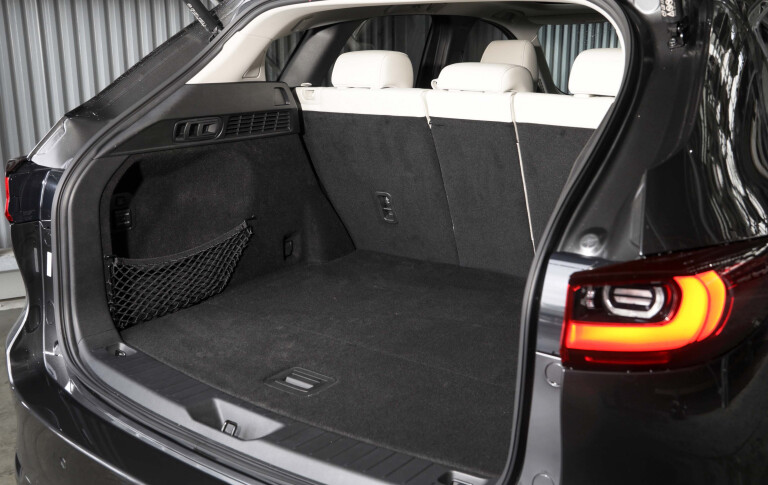
Design and equipment
The CX-60 debuts the latest iteration of Mazda’s Kodo design language and its silhouette features a longer bonnet and a more rearward glasshouse. LED headlights are standard across the range and GT model grades and above score a black honeycomb front grille.
GT models and above also score wheel arch surrounds in body colour and larger 20-inch inch wheels. The wheel arches on Evolve models are black plastic while the wheel size drops to 18-inches.
There are seven exterior colours available across the range and Mazda has also added a new signature colour for the CX-60 to join the existing hero hues of soul red crystal and machine grey. The new colour is dubbed rhodium white premium metallic and it utilises Mazda’s Takuminuri paint technology to achieve a deep and glossy finish.

Standard equipment levels are generous across the range. Entry-level Evolve variants score; rain-sensing wipers, manually adjustable seats finished in leatherette, an eight-speaker sound system, leather steering wheel/shift knob, automatic tailgate and dual-zone climate control.
Connectivity wise, the Evolve features a 10.25-inch central infotainment display and a large 12.3-inch digital dial cluster. Apple CarPlay and Android Auto are wireless and included as standard, though Mazda’s central display isn’t a touchscreen. Instead you enter commands through a rotary dial on the centre console, which can be a little finicky and laborious.
Stepping up to the mid-spec GT adds; a larger 12.3-inch central screen, leather seats that are electrically adjustable and heated in both rows, a 12-speaker Bose sound system, a heated steering wheel, Mazda’s largest ever panoramic sunroof and, in a Mazda first, a steering column that’s electrically adjustable.
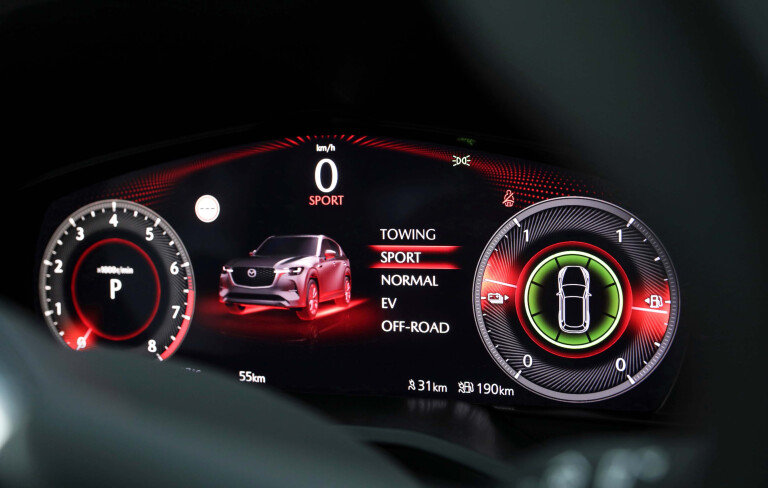
GT models and above also get a new ‘Driver Personalisation System’ that uses facial recognition tech to automatically adjust the SUV’s seating position, mirrors and other controls to your saved settings. A head-up display that’s three times the size of that fitted to a Mazda CX-30 is also included on GT and Azami variants.
The flagship Azami model grade adds; softer black Nappa leather upholstery, ventilated front seats, adaptive LED headlights, ambient LED lighting, a frameless rear-view mirror and a unique design for the 20-inch alloy wheels with a silver machined finish.
Every CX-60 scores a 360 surround-view camera as standard, but in the Azami it also offers a ‘see through function’ – which Mazda says allows the driver to see through the front and rear corners of the car usually obscured by the bodywork.
Mazda is predicting the mid-spec GT will make up half of all CX-60 sales, with the Evolve and Azami set to account for 30 and 20 per cent of sales respectively.

How safe is it?
Every Mazda CX-60 is fitted with an impressive list of passive and active safety systems which include:
| Eight airbags |
| Autonomous Emergency Braking (forward and reverse) with pedestrian and cyclist detection |
| Blind-spot monitor |
| Lane departure warning |
| Lane keep assist with steering support |
| Radar cruise control with Stop/Go function |
| Traffic sign recognition |
| Driver fatigue detection |
| Rear cross-traffic alert |
| Reversing camera |
| Tyre pressure monitoring system |
Mazda also claims the CX-60 is designed to absorb twice as much energy in a rear-end collision as an existing CX-5 – courtesy of changes to the rear crash structure. Two other safety systems also make their debut on the CX-60. A vehicle exit warning function has been added to the blind-spot monitoring system and will alert passengers if a car or cyclist is approaching if you try and exit the vehicle.
Front cross-traffic alert has also been added for the first time, and is included as standard on top-spec Azami models. It’s also available throughout the rest of the range as part of the optional $2000 Vision Technology Package.
As for a crash rating, the CX-60 recently achieved a five-star score from Euro NCAP. Mazda Australia expects to announce a five-star ANCAP rating soon.
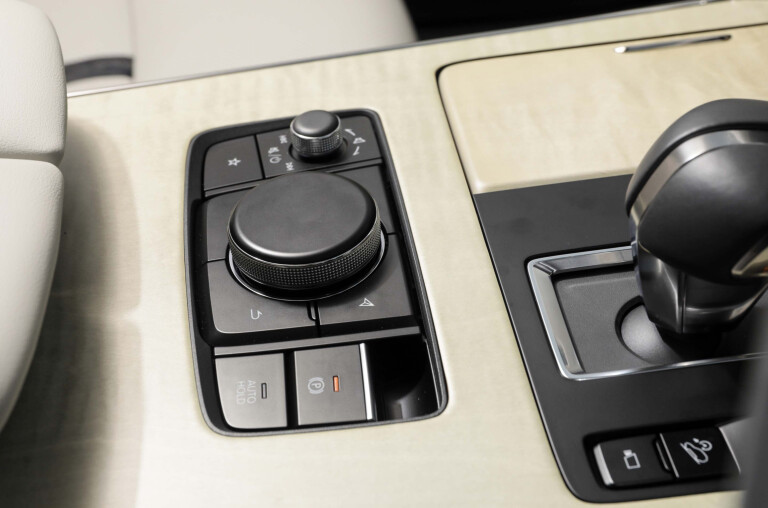
We like options...
There are four option packs available across the CX-60 model range with prices spanning between $2000-$4000.
The Vision Technology pack costs $2000 and is optional on Evolve and GT (standard on Azami). It brings:
| 360-view monitor with ‘see through view’ |
| 12.3-inch infotainment screen |
| Adaptive LED headlights |
| Driver monitoring |
| Front cross-traffic alert |
The Luxury pack is $4000 and can only be had on the entry level Evolve (standard on GT and Azami). It adds:
| Heated leather seats |
| Power adjustable seats (10-way driver; 6-way passenger) |
| Exterior mirror memory |
Flagship Azami variants can be optioned with the choice of two packs that cost $2000 each.

The Takumi pack adds:
| Cloth dashboard panel with ‘Kakenui’ sticking |
| White maple wood inserts on the doors, dash and console |
| White Nappa leather seats |
While the SP pack adds:
| 20-inch black alloy wheels (rather than black with silver finish) |
| Gloss black grille and mirrors |
| Tan Nappa leather seats |
| Two-tone steering wheel |
| Suede dashboard panel |
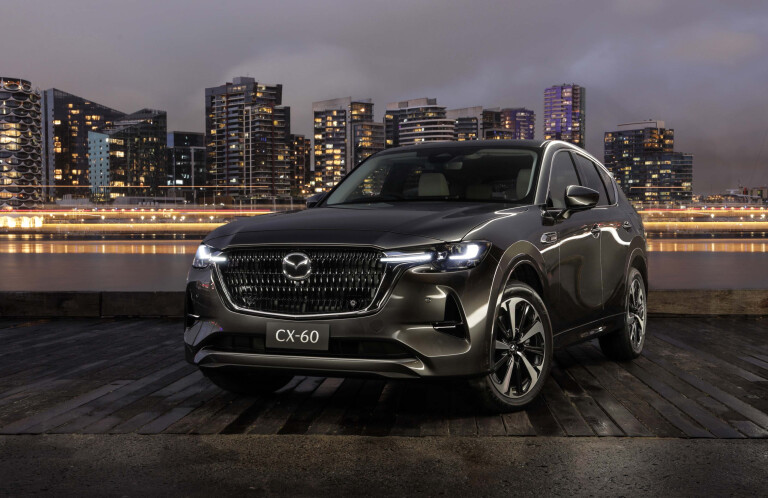
Aussie testing
Australia is one of Mazda’s largest and most important markets, and the brand conducted six months of intensive local testing for the CX-60. Two pre-production CX-60s have already racked up 22,000km of testing in Victoria with the data collected from urban and country driving sent back to Mazda HQ every fortnight.
It’s still unclear if Australian cars will feature a bespoke suspension tune for our roads or whether the data will be used to fine-tune one global set-up.



COMMENTS